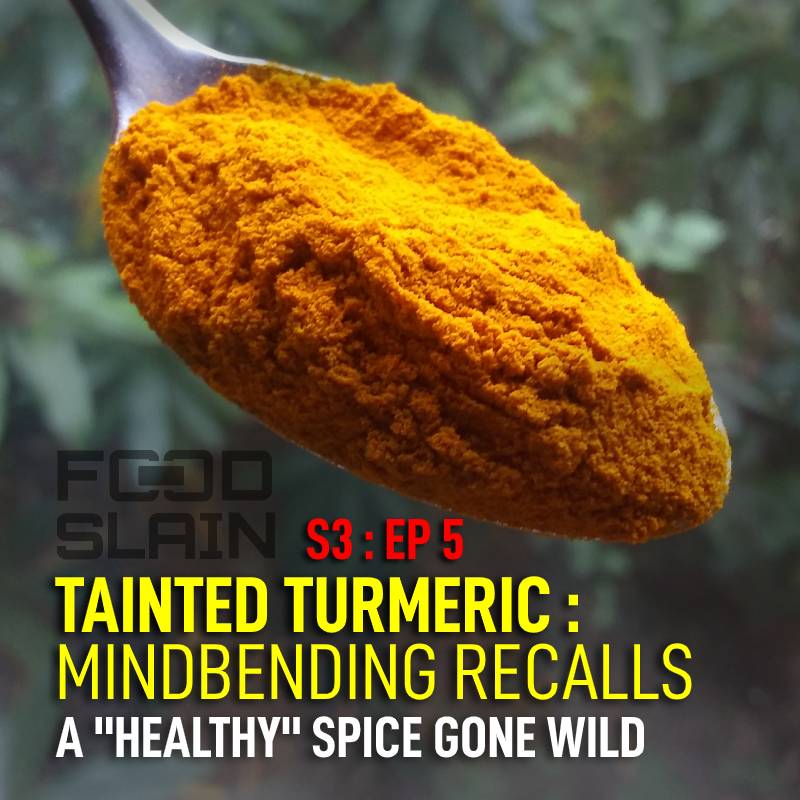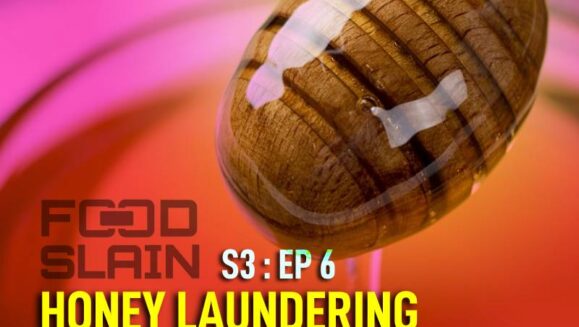Today, we’re talking about tainted turmeric and the adulteration of one of the most popular spices used around the world.
Specifically, we’re talking about dried, ground turmeric not the fresh root. And I gotta tell you…this episode is going to blow your mind.
If you’re like me, you like turmeric. It’s spicy, it’s been touted as a healthy food, maybe even a “superfood”, and it’s colorful. It’s a spice that has been used in cuisine all over the world and is an important spice that has been a staple in East and West Indian cultures for hundreds of years.
These days, you can go to your local cafe and order a turmeric latte. You can find a hundred brands of ground turmeric and turmeric supplements online and now, you can even get your “glow on” with turmeric in skin care and tooth whitening products. With all the snazzy packaging, and the inundation of marketing telling us how healthy turmeric is, we seem to have gone a little turmeric crazy.
But what if you learned that the ground turmeric you have in your spice rack that you used last night in your curry chicken dinner, or in your breakfast smoothie this morning was laced with lead?
Yes, the kind of lead they put in paint that has NO safe level for humans…
Turmeric is a multimillion dollar industry but the real question is, Why the fuck is turmeric, one of the most popular spices in our kitchen, laced with lead? Well, keep on listening, because that’s what we’re digging into today.
Wait, before we dig in…I want to just say thanks to a listener and donor to this podcast, who requested this episode. Thank you Cheryle, this one’s for you. And if you’d like to support this podcast by making a one-time (or in Cheryle’s case two time) tax deductible donation, head on over to foodslain.com and support the show. I appreciate your support! Also, it’s 9/11…a big shout out to firefighters all over the country who risk their lives to save ours! Right now on the West Coast, many of us are surrounded by wildfires, some of the worst on record, so please y’all, stay safe and support firefighters!
A LITTLE BACKGROUND ON TURMERIC – THE ECONOMICS
Okay, so first, let’s talk about money, because you gotta follow the money. Turmeric is a big business these days. According to market research, the US sales market for this spice reached $261M in 2016 and is expected to continue to grow exponentially in the next 4 to 5 years.
The largest exporter of turmeric is India and the value of turmeric exported from there to the rest of the world in 2019 reached $194 million. We can do the math, but let’s just say that right now, if you look on any online retailer, turmeric powder is selling for almost $5/lb and organic turmeric is just under $7/lb. And a 1oz spice jar sells for an average of $2.79, and over $4.50 for the organic equivalent. So, that’s almost $45/lb if we were to buy 16, one ounce jars. Freakin’ expensive. Seriously, no one is doing that.
BUT WHEN YOU LOOK AT TURMERIC FROM A HEALTH PERSPECTIVE…
We are consuming a lot of turmeric in its ground form. In 2014, 12 million pounds of it was imported into the United States, mostly from India.
Turmeric contains a phytonutrient called curcumin which has been shown to exert therapeutic and protective effects to a variety of diseases, including diabetes, neurological imbalances, autoimmune and inflammatory diseases…so, in the past 5-10 years, experts have encouraged us to put turmeric powder in your latte or cook your chicken in it with some coconut milk. Health professionals say, take a turmeric supplement for inflammation or even put it directly onto your skin for your joints in a salve or lotion…right? It’s been marketed to us as an “anti-inflammatory” wonder spice.
All you need to do is just sprinkle a little here and a little there. Feeling achey? Put some turmeric on it. Feeling a little mental fog? Take some turmeric. Some companies even promote turmeric as being beneficial at treating some cancers…just put some turmeric in your rice or your smoothie.
Sadly, the reality is, there is ground turmeric out there at your local supermarket and even online, that contains a dangerous chemical that does the opposite of what they say the benefits of turmeric are.
The additive that is mixed into some of the ground turmeric we’re consuming is lead. To be specific, it’s either lead oxide or lead chromate – which one or the other is added for a few reasons. 1.) color enhancement; 2.) to increase the weight and 3.) lead chromate has been used to “polish” the fresh root before processing. According to the New Jersey Department of Health, lead chromate can cause joint pain, it is linked to nerve damage and get this…it is a known carcinogen.
Lead, in any form is a neurotoxin and isn’t safe at ANY level. In fact, New Jersey (shout out to Jersey) is one of the states that recalled six different brands of powdered turmeric spice back in 2016…because it’s dangerous to pregnant women, children…oh, and human beings!
Again, I want to make the distinction here, that we are talking about ground, dried and processed turmeric – not the fresh rhizome or root.
So, a report from 2014 states, and I quote,
“The Bangladesh Standards and Testing Institution, the Bureau of Indian Standards, and the Indian Agricultural Produce Grading and Marking Act state that turmeric must be free from lead chromate and other artificial coloring matter. The allowable level of lead in turmeric powder is 2.5 ppm,24 10 ppm,38 and 2.5 ppm,33 according to these 3 agencies, respectively. Unlike agencies in Bangladesh and India, the FDA has not established a recommended maximum level for heavy metals (eg, lead, chromium) in spices in the United States.39,40 “
Okay, so that was in 2014…but as recently as the summer of 2019, there was a recall in NYC by a company called Makzemo LLC in Brooklyn, that was selling dried turmeric powder under the name Balquis Yemeni, which this product was distributed in Michigan and throughout the five boroughs of NY, because it had the potential of being contaminated with lead.
Since 2011, 13 companies have recalled their turmeric powder. And sadly, it isn’t just turmeric…
An article on foodsafetynews.com states that, and I quote,
“In 2018, 144 samples of paprika powder were tested for aflatoxin and Ochratoxin A in nationwide monitoring. Compared to a similar study in 2012, aflatoxin levels were slightly lower. Ochratoxin A in paprika powder was significantly higher in 2018 than for the other products examined.
In 2017, there were also studies on mycotoxin in spices. In the investigation of black pepper as well as chili and paprika spices, the levels measured were overall at low levels.
In 2018 and 2019, there were 16 and 13 alerts of mycotoxins in paprika and chili powder in the European Rapid Alert System for Food and Feed (RASFF). This corresponds to 41 percent of all reports on mycotoxins in herbs and spices in 2019.
Heavy metals and pesticide residues
Paprika powder was examined in 2018 monitoring for heavy metals. In comparison to other investigated foods, there was a higher exposure to lead, copper, chromium and aluminum. However, the maximum level for copper of 40 milligrams per kilogram was not exceeded in any samples tested.
Comparatively high levels of lead, aluminum, nickel, chromium and thallium were also found for black pepper during 2017 monitoring. Chemical elements such as heavy metals can get into food through air, water and soil.
BVL advised manufacturers to check whether the metal content in spices can be reduced by using different processing techniques.
Investigations by federal states have also often found pesticide residues in spices. In 2017, residues of several active substances were found in 70 percent of 23 chili powder samples. Almost a quarter exceeded the maximum residue limits.
A total of 13 percent of 54 paprika powder samples also had residues above the limit. In comparison, in 2018 only 2.9 percent of 137 samples of paprika powder exceeded the maximum residue levels.
A possible reason for exceeding the maximum residue levels for dried chili and paprika powder is a concentration of residues during the drying stage of the fresh products treated with pesticides, according to the BVL.
Ok….so reading all of this makes me sick to my stomach.
You know what’s interesting to me is, paprika powder is notoriously a deep red color, but a couple of years in a row, I have grown my own paprika peppers and dried them so that I have paprika powder. You know what? The color is orange, not red. So, the fact that spices like turmeric and paprika are adulterated with additives to enrich and deepen the color seems obvious when you are growing your own.
Finally, this brings us to…what can we do about it?
Obviously, we can stay informed. But this particular ingredient brings a bigger issue under scrutiny. Why do we continue to believe those who continue to promote these products and foods to us as being a “healthy” alternative, supposedly backed up by “studies” just to get us to buy more of this crap that is ultimately compromising our health?
It’s frustrating. Who can we trust? The real question is, cui bono…who benefits? I can tell you, it isn’t you or me.
WATCH THE VIDEOBut I digress….what can we do?
Well, first and foremost, you can grow your own turmeric root.
If you’re really a turmeric lover and want to continue to get some health benefits from eating it, you want to know that you are ingesting a clean form of turmeric, without lead. If you live in USDA Zone 8 or higher, you can actually grow turmeric root year round. So, know your zone.
One of my guests this season, Angel Shannon (big shout out to her) a functional medicine nurse practitioner, she grows her own turmeric root! She was going to send me some…girl, I need some clean turmeric~!
So the point is, it can be done.
Second, you can buy from smaller US producers.
Many producers do offer high quality, authentic and reliable turmeric based products. The imported stuff is the stuff that is mostly problematic. Of course, it might cost you more per pound, but everything has tradeoffs. Would you rather spend a little more for clean turmeric? Or would you rather get the cheaper stuff and have mycotoxins floating around in your brain? Just sayin’…
Third, do your research and stay informed.
Trends are just that trends….they come and go. Turmeric has been around for a long time. There are several reports put out by the Botanical Adulterants Prevention Program that state that turmeric has been adulterated since the 1980’s…that’s 40 years, and there are even synthetic versions of turmeric out there. The folks who are behind these adulterated and synthetic versions are motivated by profit and nothing else. I mean, turmeric has been one of the top selling dietary nutraceutical supplements, and it isn’t slowing down. Although there are some programs in place that test imports for lead in turmeric and spices, some of the adulterated spice is still ending up on our tables, in our cups and on our skin.
So that’s where I’m going to leave this one. You can ask google which brands of tainted turmeric spices have been recalled and find out for yourself. Check your spice rack, call the manufacturers and find out who they are importing turmeric powder from. You can surely get your own answers and figure out if you really want to drink that turmeric latte before you realize that you have accumulated lead in your body. The reality is, lead accumulates in the brain, liver, kidneys and bones. The good news is, the half life of lead in the body is only 28 days…so there’s that. But the choice is yours.
Thank you for listening to this episode of food slain.
If you know someone who eats, drinks or uses turmeric based products, and you care about them, I hope you share this episode with them and spread the word. Follow Food Slain on the socials @foodslain, subscribe to the YouTube Channel and a big thank you to everyone who has donated as little as $5 to this show. I am so grateful. You too can make a one-time donation on the website, foodslain.com. Also, thank you to my Patrons on Patreon. I deeply appreciate your support and if you’d like to support this show in that way, head on over to patreon.com/foodslain.
And stay tuned…because honey child, next week we’re digging into that sweet sweet stuff…honey! Sticky tricky business….
Until next time, remember to eat clean, eat healthy and love your food, and I’ll see you on the other side of the plate.
Chow.



